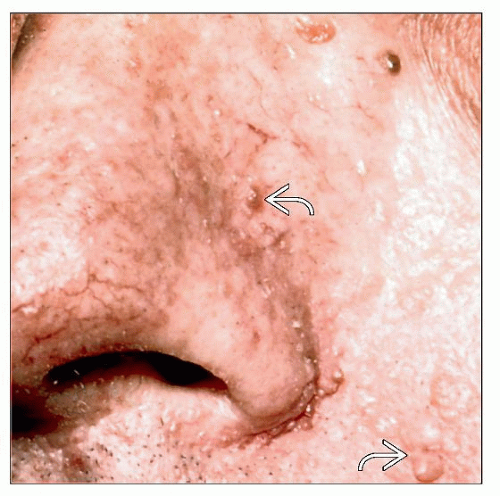Trichoepithelioma
David Cassarino, MD, PhD
Key Facts
Terminology
Trichoepithelioma (TE)
Synonyms: Superficial trichoblastoma
Basaloid follicular proliferation with a mixture of primitive follicular structures and mature infundibulocystic keratinizing areas
Etiology/Pathogenesis
Some cases are inherited as part of a genetic syndrome, including Brooke-Spiegler syndrome, familial trichoepitheliomas, or Rombo syndrome
Clinical Issues
Most commonly occur on the face, but may involve other head and neck sites
Excellent, very low recurrence or malignant potential
Microscopic Pathology
Multiple lobules and nests of basaloid cells, typically confined to superficial dermis
Scattered areas of infundibulocystic differentiation (keratinizing cysts) are typically present
Tumor is associated with fibrotic and cellular stroma
Papillary mesenchymal bodies classically are present
Calcifications and granulomatous inflammation (reaction to ruptured cysts) are often present
Top Differential Diagnoses
Basal cell carcinoma (BCC)
Microcystic adnexal carcinoma (MAC)
Trichoblastoma
Trichoadenoma
Sebaceoma
TERMINOLOGY
Abbreviations
Trichoepithelioma (TE)
Synonyms
Superficial trichoblastoma
Definitions
Basaloid follicular proliferation with mixture of primitive follicular structures and mature infundibulocystic keratinizing areas
ETIOLOGY/PATHOGENESIS
Genetic
Some cases are inherited as part of a genetic syndrome, including Brooke-Spiegler syndrome, familial trichoepitheliomas, or Rombo syndrome
Autosomal dominant inheritance
Present as multiple lesions, often with cylindromas and spiradenomas (Brooke-Spiegler syndrome)
CLINICAL ISSUES
Epidemiology
Incidence
Relatively common tumors
Age
Usually present in adults
Genetic forms present in adolescence
Gender
Slight male predominance
Site
Most commonly occur on the face, but may involve other head and neck sites
Presentation
Solitary or multiple papules
Sporadic cases are typically solitary
Inherited cases are usually multiple
Usually small (< 5 mm), especially the sporadic cases
Large or “giant” trichoepitheliomas are better referred to as trichoblastoma
Treatment
Options, risks, complications
Surgical excision is curative
Should be recommended in partial biopsies in order to exclude basal cell carcinoma (BCC)
Prognosis
Excellent; very low recurrence or malignant potential
However, rare cases have been associated with (or progressed to) BCC
MACROSCOPIC FEATURES
General Features
Small, superficial dermal-based lesion
MICROSCOPIC PATHOLOGY
Histologic Features
Stay updated, free articles. Join our Telegram channel

Full access? Get Clinical Tree








